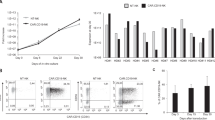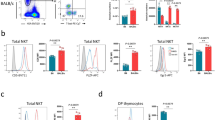Abstract
We have recently derived from human fetal blood (25 wks) a series of cloned cell lines that were selected for their ability to kill the conventional natural killer (NK) target cell K5621. It was found that a fraction of these clones express CD3 proteins but not the monomorphic Ti αβ determinant recognized by WT31 antibody1. One interleukin-2-dependent CD3+ WT31− clone, termed F6C7, was used for immunization of mice to generate monoclonal antibodies directed at a potentially novel recognition receptor. It was shown that F6C7 cells, which transcribe Ti β but not Ti α genes, surface-express a clonotypic structure, termed NKFi2. Immunoprecipitations performed with anti-NKFi monoclonal antibody (mAb) indicated that the corresponding molecule is resolved in SDS-polyacrylamide gel electrophoresis (PAGE) as a single band of relative molecular mass ∼85,000 (Mr∼85K). After reduction, a major band was detected at 44K and a faint band was present at 41K2. The present study was designed to characterize this structure. It was found that NKFi represents either two 44K disulphide-linked γ (TCR) chains, or possibly one γ chain associated to an additional undetected molecule, and that the 4IK material corresponds to a partially glycosylated fraction of the γ protein. Anti-NKFi mAb both induces a specific autocrine pro-liferative response and blocks cytotoxic function, demonstrating that γ chains serve as functional receptor structures on subpopulations of normal human lymphocytes.
This is a preview of subscription content, access via your institution
Access options
Subscribe to this journal
Receive 51 print issues and online access
$199.00 per year
only $3.90 per issue
Buy this article
- Purchase on Springer Link
- Instant access to full article PDF
Prices may be subject to local taxes which are calculated during checkout
Similar content being viewed by others
References
Nowill, A. et al. J. exp. Med. 163, 1601–1606 (1986).
Moingeon, P. et al. Nature 323, 638–640 (1986).
Elder, J. H. & Alexander, S. Proc. natn. Acad. Sci. U.S.A. 79, 4540–4544 (1982).
Plummer, T. H., Elder, J. H., Alexander, S., Phelan, A. W. & Tarentino, A. L. J. biol. Chem. 259, 10700–10704 (1984).
Yanagi, Y. et al. Nature 308, 145–149 (1984).
Hedrick, S., Nielsen, E. A., Kavaler, S., Cohen, D. I. & Davis, M. M. Nature 308, 153–158 (1984).
Chien, Y. et al. Nature 312, 31–35 (1984).
Saito, H. et al. Nature 312, 36–40 (1984).
Sim, G. K. et al. Nature 312, 771–775 (1984).
Lefranc, M. P. & Rabbits, T. H. Nature 316, 464–466 (1985).
Saito, H. et al. Nature 309, 757–762 (1984).
Kranz, D. M. et al. Nature 313, 752–755 (1985).
Hayday, A. C. et al. Cell 40, 259–269 (1985).
Murre, C. et al. Nature 316, 549–552 (1985).
Meuer, S. C. et al. Nature 303, 808–810 (1983).
Brenner, M. B. et al. Nature 322, 145–149 (1986).
Dialynas, D. P. et al. Proc. natn. Acad. Sci. U.S.A. 83, 2619–2623 (1986).
Merrifield, R. B. et al. J. Am. chem. Soc. 85, 2149–2154 (1963).
Bank, I. et al. Nature 322, 179–181 (1986).
Author information
Authors and Affiliations
Rights and permissions
About this article
Cite this article
Moingeon, P., Jitsukawa, S., Faure, F. et al. A γ-chain complex forms a functional receptor on cloned human lymphocytes with natural killer-like activity. Nature 325, 723–726 (1987). https://doi.org/10.1038/325723a0
Received:
Accepted:
Issue Date:
DOI: https://doi.org/10.1038/325723a0
This article is cited by
-
Association of increased numbers of peripheral blood double-negative T-lymphocytes with elevated serum lgG levels in severely handicapped children
European Journal of Pediatrics (1994)
-
Effect of gold therapy on CD5+ B-cells and TCR ?? + T-cells in patients with rheumatoid arthritis
Rheumatology International (1991)
-
Interleukin-2-dependent long-term cultures of low-density lymphocytes allow the proliferation of lymphokine-activated killer cells with natural killer, Tiγ/δ or TNK phenotype
Cancer Immunology Immunotherapy (1990)
-
γδ T-cell receptor repertoire in human peripheral blood and thymus
Immunogenetics (1990)
Comments
By submitting a comment you agree to abide by our Terms and Community Guidelines. If you find something abusive or that does not comply with our terms or guidelines please flag it as inappropriate.



